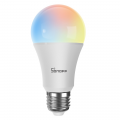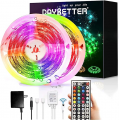I am a complete beginner at designing circuits and my English sounds like a 5-year-old talking. So, please beer with me.
I was thinking of building an aquarium light. As plants need a full spectrum of light to grow properly, this is the selection of colours I came up with by watching many YouTube videos about this topic. I also wanted to adjust each colour separately with an Arduino or esp8266.
The first problem was to control these LEDs based on colour. Which I think I have solved with help from the internet. Please check if there are any problems with the Mosfet driver section.
I am planning on powering these LEDs with a voltage and current-controllable buck converter. (The LEDs are 1W each. They are bead-type LEDs commonly used in horticulture)
Now the problem is the red and the yellow LEDs have a lower forward voltage than the rest and there is also a smaller number of yellow LEDs. So, my questions are:
1. Won't there be a lower resistance path through the red and yellow LEDs for the current to flow? Which in turn will make them brighter than the rest or possibly even damage them.
2. Is it ok to power LEDs with a higher voltage than the sum of forward voltages as long as the current is constant?
3. Is it ok to connect LEDs in parallel like in the schematic?
4. If this won't work, what are the other options I have to accomplish the goals I have?
5. And if this works (which I don't think it would) is the voltage and current (20.4V 12.6A) I'm planning on providing correspond with the need of the circuit?
Thanks in advance.
View attachment fsdgsdgn.png
I was thinking of building an aquarium light. As plants need a full spectrum of light to grow properly, this is the selection of colours I came up with by watching many YouTube videos about this topic. I also wanted to adjust each colour separately with an Arduino or esp8266.
The first problem was to control these LEDs based on colour. Which I think I have solved with help from the internet. Please check if there are any problems with the Mosfet driver section.
I am planning on powering these LEDs with a voltage and current-controllable buck converter. (The LEDs are 1W each. They are bead-type LEDs commonly used in horticulture)
Now the problem is the red and the yellow LEDs have a lower forward voltage than the rest and there is also a smaller number of yellow LEDs. So, my questions are:
1. Won't there be a lower resistance path through the red and yellow LEDs for the current to flow? Which in turn will make them brighter than the rest or possibly even damage them.
2. Is it ok to power LEDs with a higher voltage than the sum of forward voltages as long as the current is constant?
3. Is it ok to connect LEDs in parallel like in the schematic?
4. If this won't work, what are the other options I have to accomplish the goals I have?
5. And if this works (which I don't think it would) is the voltage and current (20.4V 12.6A) I'm planning on providing correspond with the need of the circuit?
Thanks in advance.
View attachment fsdgsdgn.png
Attachments
-
215.4 KB Views: 20










